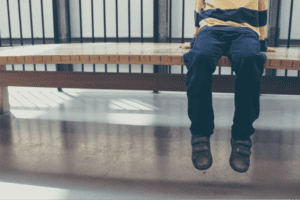
This post is the second in our series on pandemic emergency planning for families of kids with disabilities. You can read part 1 here.
A pandemic emergency plan is a plan for what to do when you and your co-parent (if you have one) are both sick and need to quarantine or go to the hospital. This is hard for most people to think about; for those of us with kids with disabilities, it can feel overwhelming.
In our first post in this series, we promised to break this down and walk you through it step by step. So let’s do this.
Step 1: Make a plan for if you are sick at home
The most likely scenario if you and others in the house get sick is that you will recover at home. (We’ll cover plans for a hospital stay in a minute). Think about how you will protect and care for your children and make sure they have what they need if you and any other adults in the home are sick.
Some things to include in your plan:
-
-
Where you will self-quarantine so you can protect your family members. (Check out the CDC guidelines)
-
A list of friends or family members who can drop off groceries, ready-made meals, or medications for you and your children
-
A list of contacts who will check in with your kids or (if your kids are younger) read a book with them on video so you can rest if your children are safe without constant “eyes-on” supervision
-
Who do you know that has already been vaccinated or had COVID? Since they have protection against being infected, they are the most likely people to be able to help.
-
If you have older kids who are safe in the kitchen, teach them how to make a few easy meals: microwave mac and cheese, pasta, scrambled eggs. Make a list of simple meals they can make themselves, like peanut butter and jelly sandwiches.
Download this template to record all of this information.
Step 2: Choose a person to take care of your child if you can’t
For some of us, our children’s needs or behavior can mean that our friends or family members don’t spend a lot of time with them. This is tough anyway, and just plain scary when we’re trying to think about an emergency caregiver to step in when you are too sick to care for your child.
But don’t panic! Think about who brought you a meal when you had the flu last fall. Who keeps checking on you when things have been hard? Who are the people who you may not see often, but who you know would run into a burning building for you? Who does your child feel comfortable with? These are your people, and it’s time to talk to them.
A few things to think about:
It may be helpful to have a #1, #2, and #3 person in case your first choice is not able to step up when you need them (don’t forget that stepping in here may mean exposure to the virus if they have not been vaccinated or had COVID already).
Travel is challenging right now, so if you can, choose someone nearby. If that’s impossible, think about a friend or neighbor who would be willing to step in for a day or two. Don’t forget – you are only asking for this if you (and your co-parent, if you have one) both get very sick.
If you share custody of your child with someone who you do not live with, you and your child’s other parent need to agree to the plan together. We know this can be a challenge. Try to stay focused on your goal: keeping your child safe in an emergency. (This article might be helpful if you are co-parenting with an ex right now).
If you have a child with significant disabilities or significant medical needs, now is the time to look into formal care options. If your child gets services through your state’s disability services system, start there. If your child is in a school for children with special needs, the school psychologist or other administrators may also be able to help.
This part of your plan should also address where your back-up caregiver will stay with your child or children if you are too sick to care for your family. Some things to consider here:
-
Does your house have the space for everyone to be safe and comfortable if you are quarantined at home?
-
Is your caregiver’s house physically accessible to your child?
-
Is your caregiver’s house safe for your child? If not, what would they need to do to make it safe – lock up medicines, toddler-proof the cabinets, put away rugs and tripping hazards?
-
If you have a service animal, is your caregiver’s home a safe place for the animal?
-
If the caregiver stays at your house, do they need a key, a door code, or an alarm code?
Don’t forget to download this template to capture all of this information.
Step 3: Write up a formal agreement and share it with anyone who needs to know.
Once your back-up caregiver agrees to the plan, you need to put it in writing. This is different from what you have in your will (if you have one), because this is a temporary plan that acts more like a permission slip for a school trip. This will allow your back-up caregiver to make decisions about medical care if your child needs it and you are too sick to consent to their care. You will need to get this form notarized (you can usually do this for free at a local bank). Here’s a great template from the American College of Emergency Physicians.
Once your agreement is in place, think about who needs to know about it. Your back-up caregiver needs a copy, of course. Do you have parents, siblings, or adult children who might try to help and need to know your plan? Teachers or babysitters who can support your child? They all need copies. Is your child old enough and capable of understanding the plan? They need to know too.
Phew! You did the hardest part. Nice work!
Watch for part 3 (the last part) of this post in a few days. We will address how to make a plan to keep your child healthy, safe, and calm if you are sick and a caregiver needs to step in.



